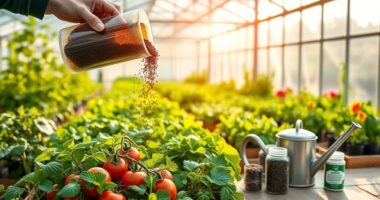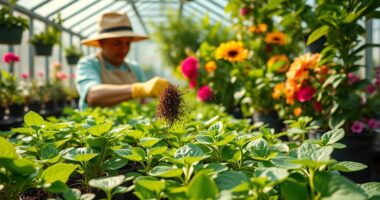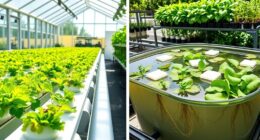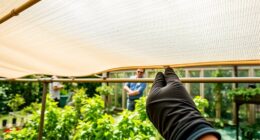In your greenhouse, consider pairing basil with tomatoes for enhanced flavor and pest control. Marigolds are excellent for repelling nematodes while attracting helpful insects. Beans enrich the soil when planted alongside corn, and the classic trio of corn, beans, and squash works wonders in confined spaces. Remember to avoid incompatible pairings like tomatoes with fennel or onions with beans. By choosing the right combinations, you can optimize growth and health—there's even more to explore on effective strategies!
Key Takeaways
- Pair basil with tomatoes to enhance flavor and repel pests effectively in the greenhouse.
- Marigolds are excellent companions as they deter nematodes and attract beneficial insects around vegetables.
- Combine beans with corn to enrich the soil with nitrogen, benefiting both crops' growth.
- Utilize the classic trio of corn, beans, and squash to support each other while maximizing space in confined areas.
- Plant lavender and rosemary together to attract pollinators, enhancing the growth of nearby fruiting crops.
Understanding Companion Planting Principles

Understanding companion planting principles can transform your garden into a thriving ecosystem. By recognizing complementary growth habits, you can create a diverse environment where tall plants like corn provide shade for leafy greens, while sprawling squash acts as ground cover.
Using vining plants on trellises helps optimize vertical space, and spreading plants maximize horizontal areas.
Balancing nutrient needs is essential; legumes fix nitrogen, benefiting heavy feeders like tomatoes. Grouping plants with similar nutrient requirements enhances soil health.
However, be cautious of negative pairings; some plants, like fennel, can stunt growth nearby. Researching compatible pairings guarantees you avoid competition for resources, leading to healthier plants and improved yields in your garden.
Benefits of Companion Planting in Greenhouses

Companion planting in greenhouses offers numerous advantages that can greatly enhance your gardening experience. By attracting pollinators, you'll likely see increased yields for crops like tomatoes and cucumbers.
Additionally, certain plants, such as garlic and marigolds, can naturally repel pests, reducing your reliance on chemical pesticides. Maximizing space is another benefit, as pairing plants with different growth habits optimizes vertical and horizontal areas.
Moreover, companion planting improves soil health through nitrogen-fixing plants and enhances disease prevention by spacing susceptible plants apart.
You'll also enjoy reduced chemical use and increased biodiversity, creating a more eco-friendly environment. Ultimately, this approach fosters a balanced ecosystem, promoting healthier plant growth in your greenhouse.
Top Companion Plant Combinations for Greenhouses

Choosing the right plant combinations can transform your greenhouse into a thriving ecosystem.
For pest control, pair basil with tomatoes to boost flavor while repelling pests. Marigolds work wonders with vegetables, deterring nematodes and attracting beneficial insects. Garlic's natural repellent properties make it a versatile companion for various crops.
To enhance pollination, combine lavender and rosemary; they attract pollinators and support growth. Nasturtiums are great with fruit crops, drawing pollinators while protecting them.
For soil health, plant beans alongside corn, as beans enrich the soil with nitrogen.
Finally, optimize space with the classic trio of corn, beans, and squash, which support each other beautifully in a confined area.
These combinations will elevate your greenhouse gardening efforts.
Plants to Avoid Pairing in Greenhouse Environments

While the right plant combinations can enhance your greenhouse, some pairings can lead to poor growth and increased pest issues.
For instance, avoid planting tomatoes with fennel or corn, as they inhibit growth and can worsen pest infestations. Brassicas like cabbage and kale also don't mix well with tomatoes due to shared nutrient needs and disease susceptibility.
Beets shouldn't be near their relatives, while onions can stunt bean growth.
When it comes to pests, keep cucumbers away from sage, and don't pair carrots with coriander. Lettuce and parsley are also incompatible due to aphid attraction.
Tips for Successful Greenhouse Companion Planting

To achieve a thriving greenhouse, it's essential to understand the principles of companion planting. Start by pairing plants with complementary growth habits—this optimizes your space.
Group those with similar nutrient needs to avoid competition. Incorporate pest-repellent plants, like marigolds, to minimize chemical use. Attract pollinators by planting flowers near fruiting crops, enhancing your harvest.
Group plants with similar nutrient needs, add pest-repellent marigolds, and attract pollinators to boost your harvest.
Also, consider microclimate creation; use taller plants to shade heat-sensitive varieties. Effective combinations include tomatoes with basil, which boosts flavor and deters pests, or lettuce with carrots, where lettuce provides beneficial shade.
Finally, employ vertical planting and interplanting to maximize your greenhouse's potential. Regularly inspect your plants and adapt your strategies for the best results.
Happy planting!
Additional Strategies for Enhancing Plant Growth

Enhancing plant growth in your greenhouse can be achieved through various innovative strategies that cater to specific needs.
Consider using Hügelkultur for improved soil fertility and water retention, or explore hydroponics and aquaponics for efficient, soil-free growing.
Vertical gardening maximizes space and enhances light access, while succession planting guarantees continuous harvests throughout the season.
You can also fine-tune your growth management by optimizing plant spacing and adjusting row orientation for better photosynthesis.
Incorporating sustainable practices like recycling organic matter and attracting pollinators will promote overall health and yield.
Frequently Asked Questions
How Can I Identify Pest-Repellent Plants for My Greenhouse?
To identify pest-repellent plants for your greenhouse, start by researching herbs like rosemary and basil, which naturally deter pests with their strong aromas.
Consider adding marigolds, known for repelling nematodes and aphids, or citronella grass to keep mosquitoes at bay.
You can also explore chrysanthemums for their ability to repel ants and fleas.
What Is the Best Way to Space Companion Plants?
When you plant tomatoes and basil together, you'll notice how well they thrive side by side.
To space companion plants effectively, consider their growth habits and nutrient needs. For instance, place taller plants like sunflowers on the north side of your garden to provide shade to shorter crops like cucumbers.
Group plants with similar watering requirements to make maintenance easier, ensuring a healthy and productive growing environment.
Can Companion Planting Improve Greenhouse Humidity Levels?
Companion planting can indeed help improve greenhouse humidity levels.
By grouping plants with similar humidity needs, you create microclimates that enhance moisture retention. Taller plants provide shade, reducing evaporation, while ground cover plants, like squash, help keep the soil moist.
Additionally, as plants transpire, they release moisture into the air, contributing to a more stable humidity environment.
Just remember, while it's beneficial, it won't directly control overall greenhouse humidity.
How Do I Know if Plants Are Compatible?
To determine if plants are compatible, start by considering their growth habits, nutrient needs, and pest management abilities.
Look for plants that share similar sunlight and water requirements. Observe how they interact; some may benefit each other, while others could hinder growth.
Pay attention to their space needs, as overcrowding can lead to competition. Finally, research any allelopathic effects, as certain plants might release chemicals that can negatively affect nearby ones.
What Tools Can Help With Tracking Plant Performance?
Did you know that using a gardening journal can increase your plant yield by up to 20%?
To track plant performance effectively, consider using gardening journals to document growth, mobile apps for real-time updates, and spreadsheets for organizing data.
Regularly capturing photos helps visualize changes over time.
Plus, installing sensors can monitor essential conditions like soil moisture.
Combining these tools enhances your understanding and management of plant health, leading to better gardening outcomes.
Conclusion
In your greenhouse garden, think of plants as dancers in a vibrant ballet. When you pair them wisely, they twirl and sway in harmony, enhancing each other's growth. Just like a skilled choreographer, you can avoid mismatched steps that lead to chaos. Embrace the rhythm of companion planting, and watch your garden flourish like a well-rehearsed performance. With a little care and creativity, your plants will create a beautiful symphony of life and abundance.









